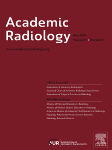
Publication date: Available online 24 November 2017
Source:Academic Radiology
Author(s): Kushaljit Singh Sodhi, Madhurima Sharma, Edward Y. Lee, Akshay Kumar Saxena, Joseph L. Mathew, Meenu Singh, Niranjan Khandelwal
Rationale and ObjectivesThe objective of this study was to assess the diagnostic utility of 3-tesla (3T) magnetic resonance imaging (MRI) of lungs in the detection of interstitial lung disease (ILD) in pediatric patients.Materials and MethodsTwelve children (mean: 8.5 years, range: 4–12 years) with ILD were consecutively enrolled in this prospective study. HRCT and 3T lung MRI were performed in all patients within 2 days of each other. The sensitivity, the specificity, the positive predictive value, and the negative predictive value of detecting lung abnormalities related to ILD with 3T lung MRI were calculated, with high-resolution computed tomography (HRCT) as a standard of reference. Agreement between HRCT and 3T lung MRI, as well as between two reviewers, was calculated with the kappa coefficient.Results3T lung MRI had low sensitivity (66.67%) and high specificity (97.33%) in the detection of abnormalities related to ILD when compared to HRCT in children. Although 3T lung MRI performed well in the detection of consolidation, parenchymal bands and fissural thickening with a sensitivity of 100%, the sensitivity of 3T lung MRI in the detection of septal thickening, ground-glass opacity, nodules, and cysts was relatively low (50.0%, 50.0%, 66.67%, and 25.0%, respectively). Substantial agreement was seen between HRCT and 3T lung MRI (k = 0.7), whereas perfect agreement was seen between two reviewers in detecting abnormalities related to pediatric ILD (k = 0.9–1.0).ConclusionsIn comparison to HRCT, 3T lung MRI with routinely available MRI protocols and sequences can also well detect abnormalities such as consolidation, parenchymal bands, and fissural thickening in children with ILD. However, evaluation of septal thickening, ground-glass opacity, nodules, and cysts is limited with 3T lung MRI.
from #MedicinebyAlexandrosSfakianakis via xlomafota13 on Inoreader http://ift.tt/2jYiK6M
via
IFTTT
